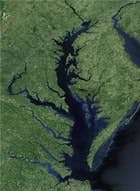The U.S. Environmental Protection Agency (EPA) announced that it reached settlement with the Chesapeake Bay Foundation, four former Maryland, Virginia and Washington, D.C., elected officials and organizations representing watermen and sports fishermen in resolving a lawsuit filed in January 2009 claiming that EPA had failed to take adequate measures to protect and restore the Chesapeake Bay. The lawsuit, Fowler v. EPA, is pending in federal district court for the District of Columbia.
The new federal strategy for the Chesapeake region, “Strategy for Protecting and Restoring the Chesapeake Bay Watershed,” was announced May 12, 2010, and is available online at http://executiveorder.chesapeakebay.net.
The settlement agreement, negotiated with groups and individuals with a long history of advocating protection and restoration of the bay, tracks much of the comprehensive suite of strong regulatory and other actions that EPA has initiated or pledged to take under the Obama administration to restore water quality in the Chesapeake Bay and its tributaries. These actions include establishing the stringent Chesapeake Bay total maximum daily load (TMDL), putting in place an effective implementation framework, expanding its review of Chesapeake Bay watershed permits and initiating rulemaking for new regulations for concentrated animal feeding operations and urban and suburban storm water. The agreement also includes a commitment to establish a publicly accessible tracking and accounting system to monitor progress in reducing pollution through the TMDL and two-year milestones.
“Because EPA and the co-plaintiffs share the same goals of clean water in the Chesapeake Bay and the waterways flowing through communities in the region, we felt that a settlement building on our common goals was far more positive than defending a lawsuit filed in the Bush administration,” said EPA Deputy Administrator Bob Perciasepe. “Through the executive order issued by President Obama, this administration is committed to making real progress in restoring water quality, and our strong actions and rigorous accountability system are evidence that EPA is serious about reducing pollution.”
By Dec. 31, 2010, EPA will establish the Chesapeake Bay TMDL, a tool of the federal Clean Water Act, that sets a strict “pollution diet” to restore the Chesapeake Bay and its tributaries. The Chesapeake TMDL will be the largest and most complex ever developed in the nation, involving pollution sources throughout a 64,000-sq-mile watershed that includes six states and the District of Columbia. In 2009, EPA announced that it expects the six watershed states and District of Columbia to provide detailed strategies for reducing pollutant loads to meet water quality standards. EPA also expects detailed schedules for implementing pollution controls and achieving pollution reductions. Progress will be measured through milestones every two years, and EPA may take action for inadequate plans or failure to meet the milestones.
More information about the TMDL is available at: http://www.epa.gov/chesapeakebaytmdl.
Source: EPA


